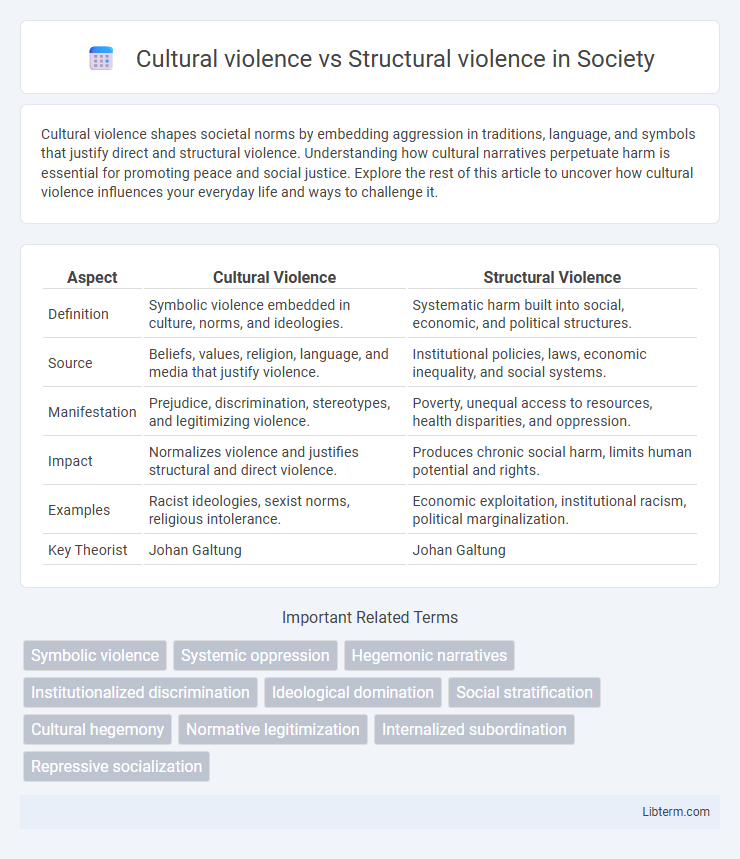Cultural violence shapes societal norms by embedding aggression in traditions, language, and symbols that justify direct and structural violence. Understanding how cultural narratives perpetuate harm is essential for promoting peace and social justice. Explore the rest of this article to uncover how cultural violence influences your everyday life and ways to challenge it.
Table of Comparison
| Aspect | Cultural Violence | Structural Violence |
|---|---|---|
| Definition | Symbolic violence embedded in culture, norms, and ideologies. | Systematic harm built into social, economic, and political structures. |
| Source | Beliefs, values, religion, language, and media that justify violence. | Institutional policies, laws, economic inequality, and social systems. |
| Manifestation | Prejudice, discrimination, stereotypes, and legitimizing violence. | Poverty, unequal access to resources, health disparities, and oppression. |
| Impact | Normalizes violence and justifies structural and direct violence. | Produces chronic social harm, limits human potential and rights. |
| Examples | Racist ideologies, sexist norms, religious intolerance. | Economic exploitation, institutional racism, political marginalization. |
| Key Theorist | Johan Galtung | Johan Galtung |
Understanding Cultural Violence: Definition and Origins
Cultural violence refers to aspects of culture--such as religion, ideology, language, art, and science--that justify or legitimize direct or structural violence, often embedding harm within societal norms and values. Originating from Johan Galtung's peace research, it highlights how dominant cultural elements can perpetuate discrimination, war, and inequality by normalizing brutality and injustice as acceptable or necessary. Understanding cultural violence involves analyzing deeply ingrained belief systems that mask structural violence, which consists of systemic social inequalities embedded in institutions and policies.
Structural Violence: An Overview
Structural violence refers to systemic inequities embedded within social, economic, and political institutions that disproportionately harm marginalized groups by limiting access to resources, opportunities, and rights. Unlike direct violence, structural violence is often invisible and normalized, manifesting through poverty, discrimination, and unequal healthcare or education systems. Understanding structural violence requires analyzing power dynamics and institutional policies that perpetuate social injustice and hinder human well-being.
Key Differences Between Cultural and Structural Violence
Cultural violence involves symbolic and ideological aspects that justify or legitimize direct and structural violence through cultural expressions such as religion, language, and art, whereas structural violence refers to systematic ways in which social structures harm or disadvantage individuals, often through unequal access to resources, political power, or rights. Cultural violence legitimizes structural violence by embedding inequality in societal norms and values, making injustices appear natural or acceptable. Structural violence is visible in institutional practices and policies that perpetuate social injustice, while cultural violence operates subtly by shaping collective consciousness and cultural acceptance of these inequalities.
Examples of Cultural Violence in Society
Examples of cultural violence in society include racial discrimination justified by stereotypes, religious intolerance promoting exclusion, and media portrayals that dehumanize marginalized groups. These forms of violence legitimize structural violence by embedding inequality in societal norms and values, such as laws that uphold segregation or economic systems that sustain poverty. Cultural violence sustains harm by normalizing prejudice and reinforcing power imbalances through cultural narratives and symbols.
Manifestations of Structural Violence in Daily Life
Structural violence manifests in daily life through systemic inequalities embedded in institutions such as healthcare, education, and law enforcement, disproportionately disadvantaging marginalized communities. This form of violence is evident in disparities like unequal access to quality medical care, underfunded schools in low-income areas, and biased criminal justice practices. These institutionalized barriers create persistent social injustice without direct physical harm, perpetuating poverty and exclusion.
Interconnectedness of Cultural and Structural Violence
Cultural violence legitimizes structural violence by embedding discriminatory beliefs, norms, and ideologies within societal values, which perpetuate inequality and systemic harm. Structural violence manifests through institutional practices and policies that produce unequal access to resources, power, and opportunities, deeply influenced by the prevailing cultural narratives that justify these disparities. The interconnectedness of cultural and structural violence creates a feedback loop where cultural beliefs normalize structural injustices, making both forms of violence deeply entrenched in social systems.
Impact of Cultural and Structural Violence on Marginalized Groups
Cultural violence normalizes discrimination and reinforces negative stereotypes, exacerbating the exclusion and stigmatization of marginalized groups. Structural violence manifests through systemic inequalities in institutions like education, healthcare, and the justice system, limiting access to essential resources and opportunities for these populations. The combined impact perpetuates cycles of poverty, social injustice, and unequal power dynamics, hindering social mobility and human rights for marginalized communities.
Role of Institutions in Perpetuating Violence
Institutions play a crucial role in perpetuating both cultural and structural violence by embedding discriminatory practices and norms into policies and social systems. Cultural violence manifests through symbolic aspects such as language, ideology, and religion that justify and normalize inequality, while structural violence is entrenched in institutional frameworks that systematically disadvantage certain groups through unequal access to resources and opportunities. The interplay between these institutions reinforces cycles of oppression by legitimizing injustice and inhibiting social change.
Strategies for Reducing Cultural and Structural Violence
Strategies for reducing cultural and structural violence involve promoting inclusive education that challenges stereotypes and prejudices embedded in societal norms. Implementing equitable policies and ensuring fair resource distribution address systemic inequalities contributing to structural violence. Community engagement and dialogue foster mutual understanding, helping to transform cultural beliefs that justify or perpetuate violence.
Future Directions: Building Inclusive and Peaceful Societies
Future directions in addressing cultural violence versus structural violence emphasize fostering inclusive policies that dismantle systemic inequalities while promoting intercultural dialogue and mutual respect. Integrating education that highlights both forms of violence can cultivate empathy and awareness, encouraging collective action towards social justice. Empowering marginalized communities through participatory governance ensures equitable resource distribution and reduces entrenched power imbalances, thereby advancing peaceful coexistence.
Cultural violence Infographic

 libterm.com
libterm.com